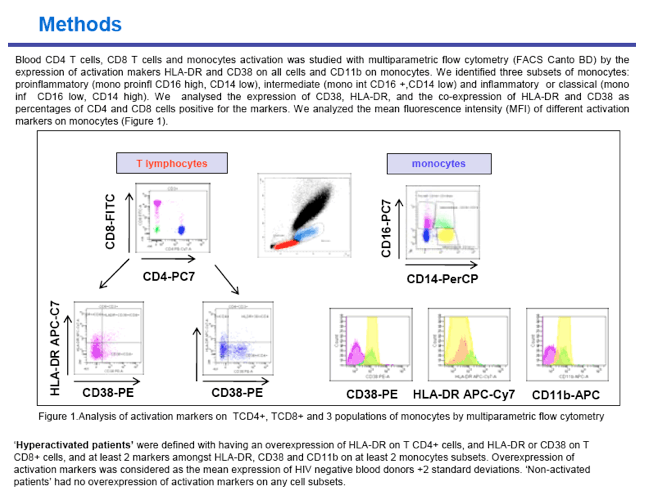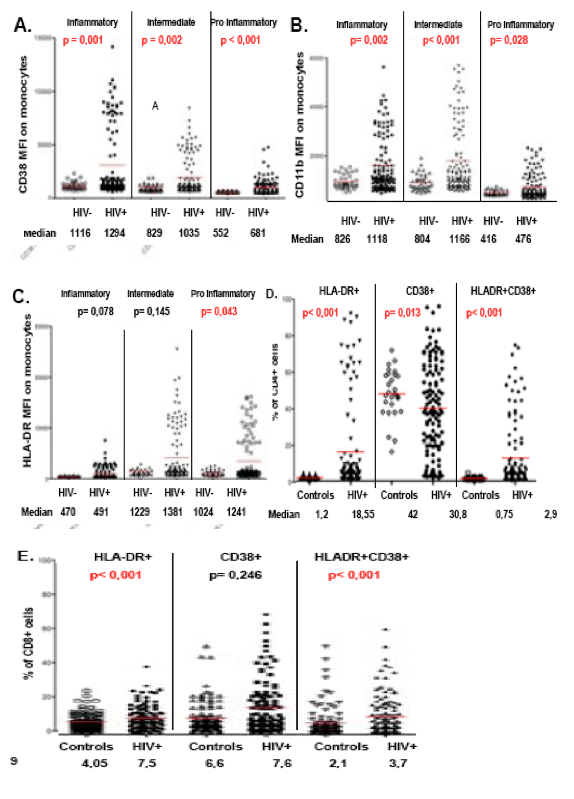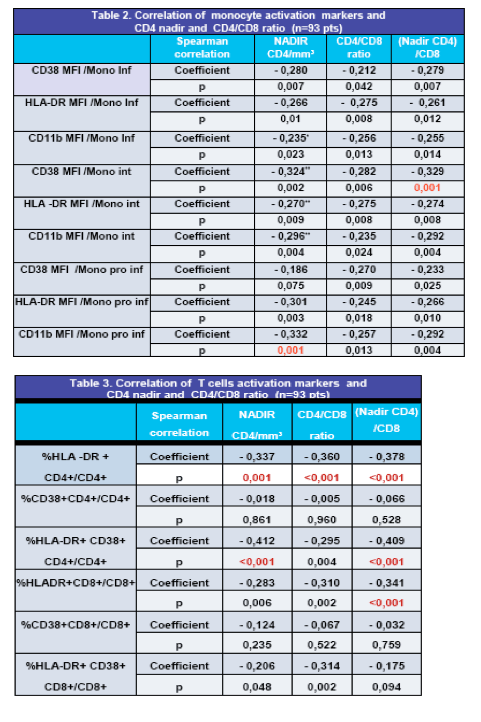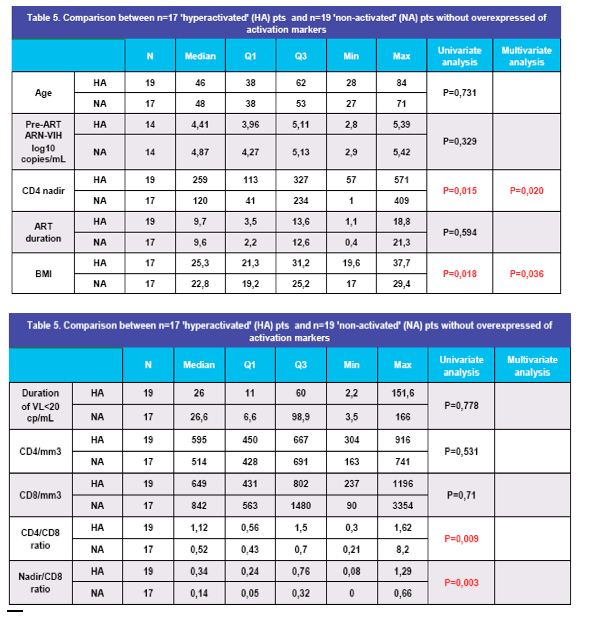 |
 |
 |
| |
CD4 Nadir Drives Persistence of Monocytes and T Lymphocytes Activation in Virologically Suppressed HIV-infected Patients
|
| |
| |
Reported by Jules Levin
CROI 2011 March 2-Feb 27 Boston
Amelie Guihot, Chiara Dentone, Christophe Parizot, Malka Tindel, Anne-Genevieve Marcelin4, Vincent Calvez4, Dominique Costagliola, Christine Katlama, Brigitte Autran, Guislaine Carcelain
1: Lab. Cell. Immunol. UMR-S945, UPMC, Pitie-Salpetriere, Paris, France; 2: Infectious Diseases Department, Sanremo, Hospital, Italy
3: Infectious Diseases INSERMU943, Pitie-Salpetriere, Paris, France; 4: Lab.Virology, Pitie-Salpetriere, Universite Pierre et Marie Curie Paris, France
INSERM U945
Hopital Pitie-Salpetriere,
83, bd de l'Hopital,
75013 Paris, France
Tel : +33 (1) 42 17 79 30
Fax: +33 (1) 42 17 74 90
amelie.guihot@psl.aphp.fr
BACKGROUND: Immune activation levels are directly associated with HIV-1 disease progression (1), but increasing evidence suggests that both serum and cellular immune activation markers persist after 12 months of effective antiretroviral therapy (2,3). Immune activation and chronic inflammation predispose to long-term complications such as atherosclerosis, cognitive impairment, osteoporosis and cancer. Persistence of immune activation in virally suppressed HIV-infected patients needs to be further characterized.
The long-term persistence of this immune activation markers needs to be further characterized since they may predispose to chronic non-infectious complications of HIV infection (4,5,6). In our study, we evaluated monocytes and lymphocytes activation markers in four groups of ART-treated patients (pts) and HIV negative controls. We correlated cellular immune activation markers with clinical and virological data.
AUTHOR CONCLUSIONS
Monocytes and T lymphocytes activation persists even in virologically suppressed HIV infection. Several mechanisms seem to be involved:
i) scar of initial CD4 depletion with persistent microbial translocation, ii) abnormal adipose tissue,
iii) failure to reconstitute CD4 cell counts,
iv) failure to decrease CD8 cell counts.
The participation of persistent low- level HIV or CMV replication, and of microbial translocation remains to be determined.
CD4 Nadir Drives Persistence of Monocytes and T Lymphocytes Activation in Virologically Suppressed HIV-infected Patients
A Guihot1, Chiara Dentone*2, C Parizot1, M Tindel3, V Calvez4, D Costagliola3, C Katlama3, B Autran1, and G Carcelain1
1UMRS945, Univ Pierre and Marie Curie, Hosp Pitie-Salpetriere, Paris, France; 2Infectious Diseases, Sanremo, Italy; 3INSERM U943, Hosp Pitie-Salpetriere, Paris, France; and 4Univ Pierre and Marie Curie, Hosp Pitie-Salpetriere, Paris, France
Background: Immune activation and chronic inflammation predispose to long-term complications such as atherosclerosis, cognitive impairment, osteoporosis and cancer. Persistence of immune activation in virally suppressed HIV-infected patients needs to be further characterized.
Methods: We studied blood monocytes, CD4 and CD8 T cell activation in a transsectionnal study of 93 consecutive patients (pts) receiving antiretroviral therapy for a median of 10 years (IQR=4-14). Expression of activation makers HLA-DR and CD38 on all cells and CD11b on monocytes were studied by flow cytometry. HIV-negative blood donors (n=39) were studied as controls.
Results: Overall 93 pts were included, of whom 70 (75%) had a plasma viral load (pVL) <20 copies/mL. Among them, 43/93 pts (46%) had CD4 cell counts > 500 cells /mm3 (median 690, IQR=595-845, group 1) and 27/93 (29%) had CD4 cell counts <500/mm3 (median 363, IQR=304-440, group 2). The remaining 23 pts (25%) had a detectable pVL (median 46 cp/mL, IQR 33-149, group 3). All monocytes and T cell activation markers were significantly increased in HIV-infected pts when compared to blood donors except CD38 on CD8+ cells. Only percentages of HLA-DR+CD8+ cells decreased with improving immunovirological status: group 3> group 2> group 1> blood donors (p=0.02), while other markers were similarly expressed in the 3 groups of pts. Monocyte expression of activation markers HLA-DR, CD38 and CD11b were negatively correlated with the CD4 nadir (p=0.01, p=0.007, and p=0.02 respectively), and with CD4/CD8 ratio (p=0.008, p=0.04, and p=0.01 respectively) in all pts. Similarly, T cell expression of HLA-DR on CD4+ and CD8+ cells was negatively correlated with the CD4 Nadir (p=0.01 and p=0.06, respectively), and with CD4/CD8 ratio (p<0.001 and p=0.002, respectively), while CD38+ cells were not. HLA-DR expression on CD4+ and CD8+ T cells were also negatively correlated with CD4 and CD8 cell counts, respectively (p=0.015 and p=0.006). In contrast CD38 expression on CD8+ cells was only negatively correlated to CD4 cell counts (p=0.003). Activation markers were not correlated with the duration of HIV infection or duration of viral suppression.
Conclusion: Monocytes and T lymphocytes activation persists even in virologically suppressed HIV infection. Activation markers are negatively associated with the CD4 nadir, suggesting the permanent scar of initial CD4 depletion establishing a persistent immunoactivation despite an optimal virological control.
PATIENTS
In a transsectionnal study, we enrolled 93 pts followed in the Infectious Diseases Department at Pitie-Salpetriere Hospital (Paris, France) : 65 males [70%]), The median age was 47 years (range [r] 27-84, IQR 26.8-44.8), the median duration of known HIV infection was 12.5 years (r 0.4-27.7, IQR 6-22), the median duration of antiretroviral therapy (ART) was 9.7 years (r 0.4-22.2, IQR 4-14). The median value of the CD4 nadir was 164/mm3 (r 1-853, IQR 73-279). N=28 (30%) pts had been diagnosed with AIDS, and the median HIVRNA preART was 4.8 .106 cp/ml (r 2.6-5.8 .106 cp/ml, IQR 4.1-5.1). The median duration of undetectable HIV-RNA was 14 months (r 0-166, IQR 1-47). At the enrollement the median CD4 ceel count was 542/mm3 [r 44-1980, IQR 364-704], the median CD8 cell count was 747 mm3 [r 90- 3354, IQR 542-1035]; the median HIV-RNA (VL) was 20 cp/ml (log) [r 20-1.2 106, IQR 20- 21]. 52% of pts were treated with a protease inhibitor ART regimen, 17% with a NNRTI regimen. Seven pts (8%) had HCV-RNA+, 4 (4%) HBsAg+ and 1 had both coinfection. and 93 HIV positive pts We collected epidemiological, virological and clinical data (Nadis database) treated with antiretroviral therapy for at least 6 months. Patients were grouped as follows:
- Group 1: n=43 pts (46%), VL ≤ 20 cp/mL, CD4 ≥500/mm3 (median 690, IQR 595-845)
- Group 2: n=27 pts (29%), VL ≤ 20 cp/mL, CD4 < 500/mm3 (median 363, IQR 304-440)
- Group 3 : n=23 pts (25%) VL >20 cp/mL (median 46 cp/mL, IQR 33-149)
- Controls VIH (-) : n=39 blood donors
N= 39 HIV negative blood donors were studied as controls.

Persistent monocyte and T lymphocyte activation during ART-treated HIV infection
All activation markers on monocytes and T cells were significantly increased in HIV pts when compared to blood donors except HLA-DR on monocytes and CD38 on CD8+ cells (Figure 2A- D). This significant difference persisted when comparing HIV- controls with undetectable pts (Group 1+ Group 2, data not shown). The repartition of monocytes subpopulations did not differ between Controls and VIH infected pts (data not shown).
Figure 2. Activation markers on monocytes (A,B,C) and TCD4+, TCD8+ (D,E) in HIV infected pts (N=93) compared to blood donors (Mann Whitney non parametric test).
The expression of HLADR on CD8+ cells decreased with improving immunovirological status: group 3> group 2> group 1> controls (p=0.02, data not shown). The repartition of monocytes subpopulations did not differ between groups of VIH infected pts (data not shown).

Monocyte and T lymphocyte activation are associated with CD4 nadir, CD4/CD8 ratio, CD4 nadir/CD8 ratio
- The CD4 nadir was negatively associated with monocyte expression of activation markers HLA-DR, CD38 and CD11b on three subsets of monocytes. The CD4/CD8 ratio at enrollment and the ratio between the CD4 nadir and the CD8 cell counts at enrollment were also negatively correlated with activation (Table 2). Similarly, HLA-DR T cell expression and HLA-DR and CD38 co-expression on CD4+ and CD8+ cells were negatively associated with the CD4 Nadir, with the CD4/CD8 ratio at enrollment, and with the ratio between the CD4 nadir and the CD8 cell counts at enrollment (Table 3).
- CD4 cell counts were negatively associated with expression of HLA-DR on CD4+, although not significantly (p=0.015). CD38 expression on CD8 cells was negatively correlated to CD4 cell counts (p=0.003, data not shown). On the contrary, CD8 cell counts were positively associated with expression of HLA-DR on CD8+, although not significantly (p=0.006).
-- Activation markers were not correlated with the BMI, the duration of HIV infection, viral suppression nor the duration of ART in the 3 groups of pts (n=93, Spearman correlation test, data not shown).
- In a multivariate analysis, the CD4 nadir was associated with %CD4+HLA-DR+CD38+, %CD8+HLA-DR+CD38+, and HLA-DR, CD11b, CD38 MFI on pro-inflammatory monocytes (data not shown). The (nadir CD4)/CD8 ratio was associated with CD38 MFI on pro-inflammatory monocytes, %CD38+CD4+ cells, and %HLA-DR+CD4+ cells. Age, sex, duration of ART, HBV or HCV co- infection, past history of AIDS, CD4 and CD8 cell counts, CD4/CD8 ratio were not independently associated with cellular activation (data not shown).

'Hyperactivated patients' have low CD4 nadir and low body mass index
'Hyperactivated patients' (HA, n=17), as defined in 'patients', were compared to 'non-activated patients' (NA, n=19). The CD4 nadir and Body mass index (BMI) were significantly lower in hyperactivated patients. In a multivariate analysis, only the CD4 nadir and the BMI were significantly different between both groups of patients.

|
| |
|
 |
 |
|
|